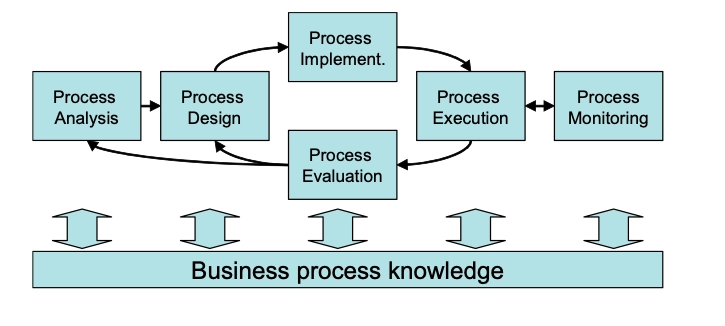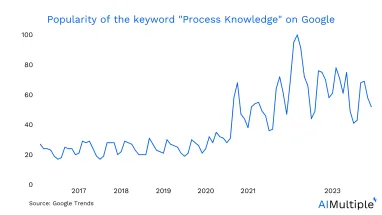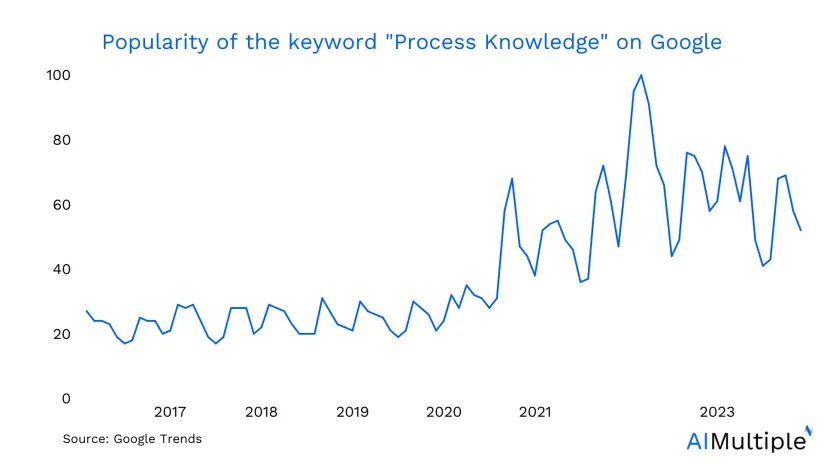76% of business leaders consider information as their most critical asset. That is a reason behind increased interest in process knowledge (see Figure above). More executives are investing in process knowledge and intelligence efforts for managing and improving their processes.
However, developing process knowledge management strategy is not easy. In fact, 60% of executives who valued knowledge management complained about the time constraint and lack of understanding for it.
In this article, we’ll explain what process knowledge is, why it matters, and how to achieve process knowledge management.
What is business process knowledge?
Process knowledge’s definition refers to any information about operations, such as the process’:
- End-goal and documentation,
- Structure and environment,
- Required resources and capabilities.
Where is process knowledge stored?
Each business stores the relevant information about its operations on:
- Written physical documents,
- Emails, cloud, excel and word files,
- Drawings and calculations,
- Specifications for process designs,
- Process tools and workflow management systems,
- Best practices and benchmarks,
- Previous improvement and management projects,
- ERP systems.
What are the five categories of process knowledge?
Process knowledge can be divided into 5 categories based on the question they respond to:
- Process logic looks for processes and tasks with their connections, operators and conditions.
- Process information covers the input and output of processes and resources required for the process execution.
- Process environment refers to all obstacles, success and interference factors.
- Process capacity provides measurement categories, metrics, points, performance indicators and target values.
- Process justification explains why the process is necessary in the first place.
All these categories paint a complete picture of the selected process.
Why is process knowledge important?
Process knowledge is essential for:
- Understanding process execution,
- Assessing process performance, integrity and compliance,
- Identifying process risks,
- Facilitating personal and organizational training,
- Ensuring proper documentation,
- Developing process improvement and management strategies.
How is process knowledge management related to business process management?
While developing process improvement and management strategies, analysts go through the BPM (business process management) cycle, which:
- Starts with process analysis,
- Translates to process implementation, execution and monitoring,
- Continues with evaluation and redesign,
- And finalizes at the process re-analysis step.
Figure below illustrates how process knowledge is associated with BPM cycles since it is required at each step. The knowledge also advances or expands according to the changes implemented or actions taken at each stage.

Check out how to implement process improvement techniques or process improvement tools to manage and improve processes.
What are the top process knowledge tools?
Various tools help gain process knowledge to improve and manage your processes and operations, including:
- Workflow management software
- Business process management software
- Low-code/No-code development platform
- Onboarding software
- Process mining
- Business process automation software.
What are the best practices to achieve process knowledge?
To remain agile, predict risk and improve performance, business leaders must manage their process knowledge.
Process knowledge management is developing and maintaining accurate, understandable and updated process knowledge while storing it in a simple and accessible way.
Here are the 3 steps to achieve process knowledge management:
1. Model your processes
The first step in process knowledge is to generate accurate and simple process models.
Process modeling visualizes processes, including every task, activity, event and step in a workflow. It provides other details such as employees involved in these steps, tools used, decision points and timeline.
An accurate process model can allow you to
- Standardize your processes,
- Formalize the communication across teams,
- Manage and control your operations,
- Train new employees.
Quick tip:
Utilize a process modeling or process mining software to capture and map your processes automatically. Some process mining vendors can generate a digital twin of an organization (DTO) or advanced process simulation capabilities.
2. Understand the way process work
While modeling your processes, you should ensure that they reflect reality.
Process models rely on process designs and plans. However, these designs are the ideal workflows a company aims to follow. In reality, how employees execute the operations might vary and become complicated.
In some cases, these variations occur due to omitted factors or changing environments, while in others, because of different practices. Some of these variations can be short-cuts and helpful for the company, while many threaten efficiency and customer satisfaction.
You can leverage your process data to understand how your processes are executed. You can compare these models driven by process data against the ideal models, identify the alternative trials and assess the level of compliance with the happy paths. You can also estimate the level of automation for the process activities and tasks.
Quick tip:
Use process mining or automated process discovery tools to collect and discover your process data automatically.
3. Enable data-driven decision-making
Develop KPIs to measure your processes’ effectiveness, efficiency and compliance levels.
Once you discover your real-life processes, you should compare them against these KPIs to identify tasks and employee activities that lead to higher lead time and cost or lower customer satisfaction.
Such insights can guide you to reallocate your resources, develop better strategies and enable data-driven decision-making. You can redesign your processes or implement changes and automation initiatives.
Quick tip:
Leverage process mining to customize KPIs or run conformance checks against predefined metrics to assess your process performance.
Explore how process mining can help you establish personalized KPIs.
Further reading
Explore how process mining can improve your process performance and manage your processes:
Check out our data-driven and comprehensive process mining vendor list to choose the right fit for you.
If you need more help finding the right vendor, let us know:
External Links
- 1. “.The Business Process Knowledge Framework.” Researchgate. Retrieved September 20, 2024.




Comments
Your email address will not be published. All fields are required.